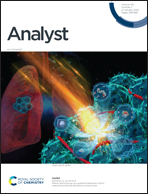Target-activated DNA nanomachines for the ATP detection based on the SERS of plasmonic coupling from gold nanoparticle aggregation†
Abstract
The self-assembly of plasmonic nanoparticles provides a powerful approach to generate surface-enhanced Raman scattering (SERS), which promotes the actual applications in chemical and biomolecular analyses. Herein, we developed a facile SERS sensing strategy for an ATP assay with a 3-D DNA nanomachine that walks by the Exo III cleavage, leading to the formation of AuNP aggregates, which resulted in the enhancement of the electromagnetic field. Depending on the target-activated Exo III cleavage, the 3-D nanomachine can walk along the 3-D track on the surface of AuNPs and generate self-assembled hot-spots to enhance the SERS signal of a Raman dye, allowing a homogenous assay of the ATP concentration with high sensitivity and reproducibility. Under optimized experimental conditions, the biosensor detected ATP with a widened dynamic range from 1 pM to 1 × 105 pM with a limit of detection of up to 0.29 pM. Hence, the novel strategy provides a useful and practical platform for the SERS assay of ATP with high sensitivity and repeatability. Besides, this platform shows great potential for applications in high-throughput assays for drug screening and clinical diagnostics.



 Please wait while we load your content...
Please wait while we load your content...